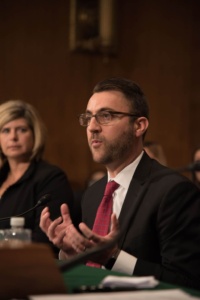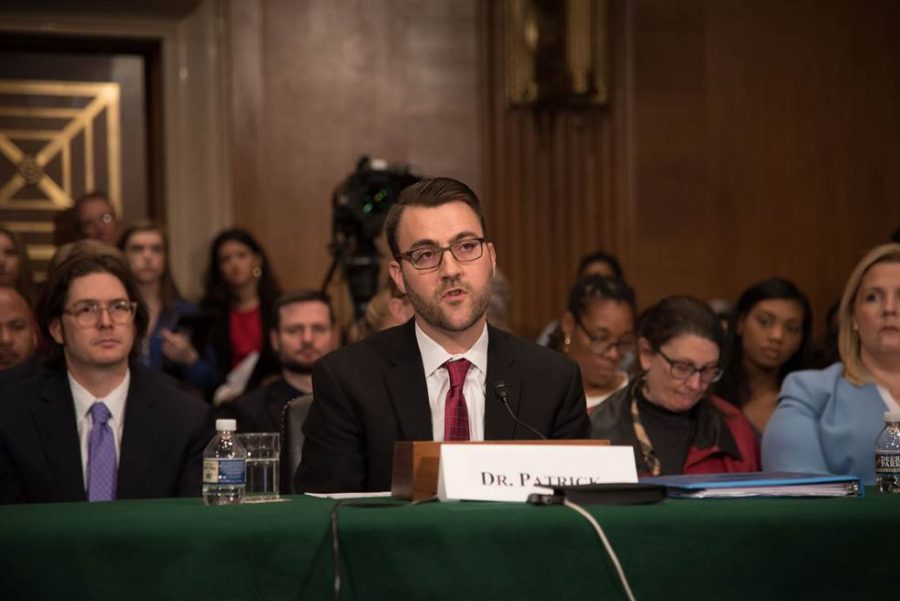Dr. Stephen Patrick is a Professor of Pediatrics and Health Policy at Vanderbilt University School of Medicine and a Neonatologist at Vanderbilt University Medical Center and Vanderbilt Children’s Hospital. In February, Dr. Patrick was asked by the U.S. Senate Health Education Labor Help Committee to speak at a hearing they held to discuss the impact of the opioid epidemic on children and families. One of the main topics that Dr. Patrick discussed was Neonatal Abstinence Syndrome (NAS), which occurs when infants experience drug withdrawal following their mother’s chronic use of opioids during pregnancy.
Vanderbilt Hustler: What kinds of issues did you discuss at the hearing?
Dr. Stephen Patrick: They asked me to talk a little bit about some of our team’s work here, and our work is really focused on the impact the opioid epidemic has had on pregnant women and infants, and we found a substantial increase in the number of infants that have had drug withdrawal from opioids. That’s increased substantially over the last 20 years or so, and it’s something our team has been working to improve, from the way we deliver care in the hospital to try and inform policy change both at the state and federal level to try and improve outcomes for infants as well as their mothers.
These issues are somewhat complicated in terms of thinking about all of the potential ways you could improve outcomes for families, but one of the things we find for pregnant women is they have a very difficult time getting access to the treatment that we know improves their outcomes as well as their infant outcomes. One of those is treatment for their opioid use disorder. We know that less than half of the pregnant women nationally that have opioid addiction are able to get evidence based treatment, which includes medications like buprenorphine and methadone. We know that those medications decrease the likelihood that a pregnant woman will die from overdose and increase the chance that the infant will go to term, so improving access to those medications is really important.
Addiction can happen to anyone at anytime at any place, and I think this realization that we’re all vulnerable is really important.
Some of the other things we discussed were that we’re trying to standardize the care that we deliver to infants that are opioid exposed. On average in the US, infants who have drug withdrawal treated with medication stay in the hospital 23 days after birth, and we can do a lot to improve that. One of the biggest things we discussed is the child welfare system. Congress passed a series of laws in 2016 with the goal of having our child welfare system not only keep the infant safe, but also work to improve outcomes for the family members, especially mom. That’s been implemented in a really uneven way, in part because the federal government really hasn’t provided any money or guidance to states on how to implement any of those policies, so one of the things we discussed was what Congress could do to provide more resources or guidance to states so that they could keep infants safe but also try and help their families and keep families in tact when possible.
VH: What’s the current state of the opioid epidemic and how could de-stigmatization help expecting mothers who are suffering from opioid addiction?
SP: Throughout the US, we’ve seen a huge spike in opioid use, and that first began with prescription opioid use. Over the last decade, we saw about a fourfold increase in prescriptions written for opioid pain relievers. More recently, we’ve seen an increase in deaths from heroin and illicit fentanyl and these are both pretty potent drugs. What we think is happening is as we’ve had more attention on controlling how we’re prescribing prescription opioids, people who already have dependency are switching to cheaper and more readily available heroin that they can get from the street, and that’s risky. One thing that’s become clear to me over time is that addiction can happen to anyone at anytime at any place, and I think this realization that we’re all vulnerable is really important as we think about how we make positive change moving forward. Addiction is a chronic relapsing medical condition, just like diabetes is a chronic relapsing medical condition, and I see the complications the babies have from addiction, but I also see the complications perhaps that are more severe from maternal diabetes in the hospital, and we don’t stigmatize pregnant women with uncontrolled diabetes. That wouldn’t be productive, and thrusting judgment on people is never productive. We shouldn’t be doing that to people with addiction. We should work to try and improve their outcomes. It’s increasingly clear to me, and it should be intuitive that what’s good for mom is good for baby. If we take care of pregnant women and we improve their outcomes, babies are going to do better, too. We really have to keep in mind the needs of both the pregnant women and their infants if we want to really make a difference in outcomes.
VH: How did we get to where we are now with the opioid epidemic and how is it affecting families?
 SP: As a neonatologist, I was trained to take care of very small babies and very sick babies with complicated birth defects, and probably around 6 or 7 years ago, we started seeing a different kind of baby show up. These were bigger term babies that were having withdrawal from opioids. We began to see more infants that are having drug withdrawal in the ICU and we began to wonder if what we were seeing in our ICU is happening elsewhere. That’s where we started describing these national increases in Neonatal Abstinence Syndrome (NAS) and our research nationally has described an increase in NAS of about sevenfold since 2000, so a really stark increase, and we’ve found that it’s increased more in rural areas of the US. We’ve done a series of things to try to improve outcomes for families and to try to improve the science around how we care for infants with drug withdrawal.
SP: As a neonatologist, I was trained to take care of very small babies and very sick babies with complicated birth defects, and probably around 6 or 7 years ago, we started seeing a different kind of baby show up. These were bigger term babies that were having withdrawal from opioids. We began to see more infants that are having drug withdrawal in the ICU and we began to wonder if what we were seeing in our ICU is happening elsewhere. That’s where we started describing these national increases in Neonatal Abstinence Syndrome (NAS) and our research nationally has described an increase in NAS of about sevenfold since 2000, so a really stark increase, and we’ve found that it’s increased more in rural areas of the US. We’ve done a series of things to try to improve outcomes for families and to try to improve the science around how we care for infants with drug withdrawal.
VH: What are you advocating for going forward and what is Vanderbilt as an institution doing to make that happen?
SP: Quite a lot. So, in September we launched a program to change the way we care for infants that are opioid exposed. We had been slowly changing what we were doing over time, but we really formalized in September. Nationwide, if you go to most hospitals, infants that have drug withdrawal are cared for in a neonatal intensive care unit (NICU), but those infants really aren’t that sick, and if you put them into the NICU, that separates them from their mom, and it makes them do worse . What they need is support, and oftentimes what they need is their mom, and that sounds simple but it’s true. So we now keep moms and babies together. We keep them out of the NICU almost all the time. We have created ancillary support for moms to breastfeed if they meet the criteria to breastfeed, if they’re not actively using illegal drugs, as an example. We’ve hired some support for moms and families, including child life specialists, who also help coordinate volunteer cuddlers within the hospital, and we’ve seen a big reduction in how long babies are staying in the hospital in a pretty short time, and those teams are great, because they’ve included a multidisciplinary group. We have social workers, we have lactation specialists, nurses and doctors, so that’s been really fun. Our research is continuing to grow too. We’re doing some work to try to understand what the barriers are to pregnant women getting the treatment they need for opioid use disorder, and we’re doing some research on how we can improve outcomes for infants after they’re born and the way we treat them.
Talking about substance use is important for all of us, and just because it’s a prescribed pill doesn’t mean it’s safe.
VH: How is the epidemic affecting our community?
SP: In our community, some first responders, some police officers are starting to carry the drug naloxone. Naloxone is a reversal drug, and we have it in a hospital. The way you die from an opioid is it depresses your breathing, and you slowly stop breathing and you die. Naloxone reverses that, and you give it either intra-nasally, so through the nose, or an injection and it’s pretty dramatic. You see people that are getting ready to die start breathing pretty quickly, so police and Metro are starting to carry that drug now. It’s important that somebody gets it. Just like you would have an external defibrillator we would see around campus, Naloxone is an important thing to have around for people that have an overdose.
VH: Do you have any words for students specifically?
SP: Students are at risk like everyone else is at risk. For young adults, some of the most common ways that they begin to use an opioid is a diverted opioid from somebody else’s prescription. People die from using opioids, particularly an opioid combined with other substances like alcohol. This can happen to anyone, and talking about substance use is important for all of us, and just because it’s a prescribed pill doesn’t mean it’s safe. There are also counterfeit pills out there too, so if you’re at a party and you see a pill it may or may not be what you think it is. What we’re starting to see getting picked up in the community are things like it looks like a Xanax pill but it’s actually compressed fentanyl, and fentanyl is 50 to 100 times more potent than heroin and that’s why people die from it. So, be careful. Most overdose deaths are a combination of drugs. It’s common that it’s an opioid plus Xanax plus alcohol, so it’s usually multiple drugs together. I see this in a hospital when I do a procedure if I’m putting a breathing tube in a baby, the medicines I give are an opioid and a benzodiazepine. They work to calm the baby down and stop the breathing so we can put in a breathing tube. These are medicines we use in the hospital, and they can have a pretty profound effect outside the hospital, too.
Dr. Patrick’s full written testimony is available here.











